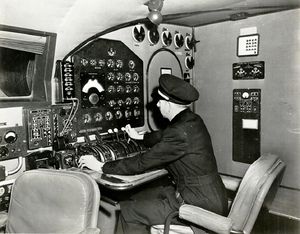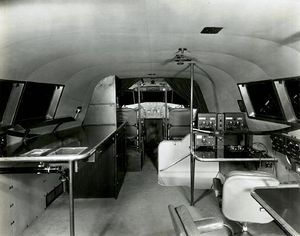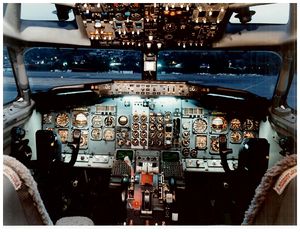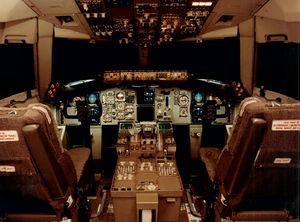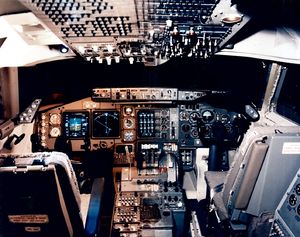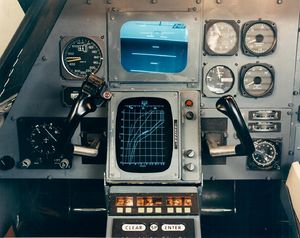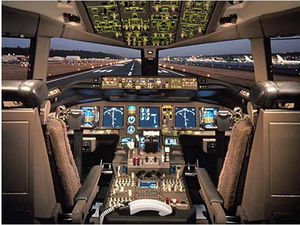First-Hand:Evolution of the 2-Person Crew Jet Transport Flight Deck
Contributors:
Delmar M. Fadden, Peter M. Morton, Richard W. Taylor, and Thomas Lindberg
Preface: We, (Delmar Fadden and Peter Morton, Richard W. Taylor and Tom Lindberg) were all working at Boeing when the idea of the 2-person electronic cockpit for commercial transports was first talked about. Individually and collectively we had direct involvement in the early discussions leading up to the project and during various stages of the project’s design, development, and testing. What follows are our recollections of how this important development in aviation history came to be and the road we followed to make the innovation of a 2-person electronic cockpit a reality.
Early History—1920 Through the Introduction of Jet Transports:
The crew size on early transport airplanes was largely determined by the mission of the airplane and functionality of the equipment installed on the airplane. While two pilots might have been sufficient for single or twin engine small airplanes flying short missions over land; longer missions typically involved more engines, celestial navigation and erratic radio communications. For these airplanes a crew of five was the norm: two pilots, a flight engineer, a navigator, and a radio operator.
The equipment on these airplanes was often designed for the particular mission of the airplane and generally reflected the specific needs and preferences of the initial customer for the airplane. Many different crew station layouts and arrangements were devised. Airline and pilot experience with one airplane type played a significant role in creating the requirements and expectation for the next airplane type. Stability in the types of operation each airline specialized in and airline employment stability tended to make these requirements airline specific. However the aviation design and manufacturing business was anything but stable; advancements in aerodynamics and engines occurred at a rapid pace.
Systems and instrumentation in this period were implemented using analog electro-mechanical or purely mechanical designs. Every meter, gauge, indicator and readout needed its own space. Most electrical controls in this era were built around switches and relays. In general, functions remained fairly simple, since every additional relay or switch reduced system reliability. The rapid advances in commercial radio led to significant improvements in radio communications for aviation, both on the ground and in the air. So much so that radio operators became unnecessary, at least for flights over populated areas.
After World War II, the new understanding of automatic controls that had developed during the war was applied to commercial airplanes. Miniature vacuum tube technology made it possible to automate a variety of routine functions; though reliability concerns constrained such applications to those having the greatest value. Right after the introduction of the first generation commercial jet transports in the mid 1950’s, solid state electronics started the trend toward miniaturization and improved reliability. But the real gains in capability, performance, and reliability would have to wait until the development of complex integrated circuits, in particular the microprocessor, in the mid 1970’s.
Prior to the war, radio navigation was restricted to radio ranges and later automatic direction finding equipment (ADF.) These systems simplified navigation over land areas but had significant limitations. The deployment of the VHF Omni-directional Radio Range (VOR) system in the 1950s eliminated the need for navigators on flights over land. During and after the war, the Long Range Aid to Navigation (LORAN) system improved overwater navigation but the operating procedures for LORAN were demanding and time consuming. The requirement for a navigator on intercontinental flights would continue until the advent of the airborne Inertial Navigation System (INS) in the late 1960s.
Commercial piston engines in the post war period were significantly more powerful than their pre-war predecessors. To achieve the higher power they incorporated turbo-superchargers and more demanding cooling systems with even more need for in-flight adjustment. New instrumentation, including ignition analyzers, was added to facilitate troubleshooting. It appeared that the flight engineer would be kept very busy. But the jet engine changed all that. These engines did not require any adjustment in-flight and troubleshooting opportunities were limited to subsystems and not the engine itself.
For most of this period, human interface design was based largely on trial and error and capturing ideas that had worked well on past airplanes. Corporate memory about what worked well was vested in many different design groups, program test pilots, and the often strong views of the launch airline chief pilots. A troublesome side effect of this quasi-independent design approach was inconsistency in the way various systems and functions were operated. While training departments and line pilots were aware of this problem, there were few tools available to correct it during the design process.
In the 1950s, university researchers Paul Fitts, Stan Roscoe, and others began developing a more scientific understanding of pilot workload and performance. Such knowledge provided a solid basis for evaluating alternative control and display designs and layouts. This in turn spurred a new efficiency in the practice of flight deck design.
Retired Boeing flight deck engineer, Jeffrey Ohlson, provides a detailed history dating back to predecessor piston-powered transport airplanes, reference 1.
737 Crew Size
When Boeing initiated the original 737 airplane design, the FAA had just published Federal Aviation Regulations (FAR) Part 25 for certification of new transport aircraft which required a rational analysis and demonstration of crew workload. This requirement formalized much greater attention to airplane systems, flight guidance, and control system design and changed the fundamental nature of flight deck design.
Early in the preliminary design effort, Boeing had taken a careful look at the in service performance and accident history of previous airplane designs. The conclusions were interesting:
- In flight troubleshooting sometimes led to more serious problems, occasionally jeopardizing the safety of the flight.
- The flight engineer’s intense focus on systems problems often distracted one or both of the pilots, sometimes resulting in no one “flying the airplane.”
- Jet engine reliability was much higher than piston engines and they required little or no in flight troubleshooting or adjustment.
- Certain high workload periods during departure and arrival left little time for outside watch nor much time for handling abnormal events.
In support of industry work to establish rational external vision requirements for transport airplanes, Boeing developed a computer model that determined the relative collision threat value of the visual space around the aircraft. Because airplanes are in motion and at a positive angle of attack, the computer model showed that the collision threat is concentrated generally forward and below the longitudinal axis of the airplane.
In response to these findings the design team took a different approach to the 737 flight deck:
- A concerted effort would be made to simplify systems designs to increase reliability and to eliminate or greatly reduce the need for in flight trouble shooting.
- A Flight Deck design group would participate in all flight deck design decisions and would have considerable authority in the design of controls, indicators, and operating concepts across all airplane systems.
- Workload assessment would be used as an integral element of design to adjust functionality and location of equipment and controls.
- Operating procedures would be simplified and shortened to reduce distractions and provide ample time for outside watch.
- The autopilot would be improved to better support operations in the terminal area not just in cruise.
- The pilot’s stations would be designed to maximize external vision in the primary collision threat zone.
Strong labor union initiatives toward a minimum crew of three in future designs would have hampered the 737 economic performance compared to its rivals (see reference 1 for more detail). The fact that some prominent US airlines agreed to operate the 737 with a third crew member created a lively marketing environment against the rival (2-person crew) DC-9 and BAC-111.
As design work toward these objectives progressed, the Boeing team became convinced that a two person design for the 737 would be significantly better than a traditional three person crew design. So much better, in fact, the Company decided to commit to a 2-crew design notwithstanding the more rigorous certification requirements and the outspoken resistance of the pilot and flight engineer labor unions.
Certification of the airplane crew workload involved analysis and careful management of hand, eye, and cognitive workload during all flight conditions. A certification flight demonstration program was conducted in a high density U.S. East coast traffic environment in late November, 1967 during which airplane systems failures and crew incapacitation were simulated. The Boeing and FAA pilots had no difficulty handling the airplane. A film was made documenting a single pilot (the right seat was empty) coping with engine fire on takeoff, failure of the autopilot, runaway stabilizer trim, and a hydraulic failure necessitating manual extension of the gear and alternate extension of the flaps. This program resulted in FAA approval of two pilots as the minimum crew size for the 737. Foreign regulators also universally accepted the FAA finding.
The biggest U.S. 737 operator, United Air Lines, negotiated contracts that retained 3 crew members but included a provision for in-flight study. The union position that a “third pair of eyes” improved the opportunity to detect collision threat had enough public appeal that a large amount of data had been gathered in the early years of 737 operation by United Air Lines pilots flying the airplane with both two and three person crews. The data seemed to suggest that indeed the third person did see more aircraft.
A more in depth analysis provided a very different perspective. Indeed the crews on airplanes flown with three pilots did see more aircraft. Interestingly, the 2-person crews saw significantly more aircraft than the two pilots on the 3-person airplanes. But because the 3rd pilot sits much further aft and lower than the pilots sitting at the two forward pilot’s stations, the target aircraft that the 3rd person can see are in a position where collision is highly unlikely. In this situation, if the two forward pilots relax their outside watch, the opportunity for an undetected collision event actually increases.
The results of these studies and on-going comparisons with world-wide accident/incident data convinced Boeing that the third pair of eyes was not a positive factor in avoiding mid-air collisions.
One U.S. carrier reached an accommodation with the pilots’ union by adding an electronic aid that helped detect other nearby aircraft.
A pilot strike at Wein/Consolidated Airline in Alaska in 1977 was settled in favor of two pilots but only after extensive hearings by a three judge panel. This trend continued as other US airlines negotiated two pilot contracts and the industry gradually evolved toward a two pilot complement for the 737.
757/767 Crew Size
At the time of the 767 development a number of the major airlines had substantially capitulated to union demands that "all future transport airplanes would be designed for three crew members". Interestingly the techniques of airplane system design for simplicity of operation had significantly improved, microprocessor-based system controllers had increased functional capability and made redundancy more ‘friendly,’ microprocessors also made possible the automation of functions previously considered too complex to apply to commercial aircraft, cathode ray tube displays now offered new opportunities to improve situational awareness of the flight crew. These changes promised to significantly improve the operational efficiency and reliability of the airplane. They also further reduced the small amount of useful workload that could be assigned to a third crew member. In the tight knit flight deck environment, occupying a crew station with a member that has little useful work to perform would be an invitation to distraction and, contrary to the intent of the labor unions, could actually cause a decrease in the safety of operations.
Dr. Frank Ruggiero from the Boeing Flight Deck Technology group correlated the extensive psychological literature on dyads and triads to the operation of a flight crew. This rich field of study provided strong evidence of much more team complexity in 3-person groups as compared with 2-person groups. Issues related to coalition formation, distraction, and the need for more extensive verbal coordination in 3-person crews were shown to have the roots in normal human behavior that starts with childhood and continues, with far greater sophistication, through adulthood. From the viewpoint of the psychologists the best crew size was the absolute minimum number of people it took to complete the work.
The launch customers for the 757 airplane (Eastern Airlines and British Airways), following the 767 by only a few months, specified a two crew member design. In response, the Airline Pilots Association bypassed the collective bargaining environment and petitioned directly to President Reagan to require three crew members in all future transport designs. Secretary of Transportation, Drew Lewis, appointed a special task force headed by former FAA Administrator John McLucas to investigate and make a final determination on the relative safety of two and three crew member flight decks. In addition to Dr. McLucas, the task force included Fred Drinkwater from NASA and USAF General Howard Leaf. Dr. John Lauber headed a support team of NASA experts who assisted the Task Force.
The task force did a thorough job of getting information from and asking questions of labor unions, airlines both foreign and domestic, and manufacturers. The final testimony was presented at a public hearing in Washington D.C. but was preceded by visits to multiple sites in the US.
Given the large number of airplanes in operation with three (707, 727,747, etc) crewmembers and with two (DC-9, BAC-111, 737, etc) crewmembers, there was ample safety data to explore. And now there was an independent technical team who looked over the “third pair of eyes” studies and reached the same conclusion as Boeing and the three-judge Wein panel had. The Task Force made its determination that "three crew members are not safer than two" while the 767 and 757 were still undergoing certification testing; the former about five months ahead of the latter. This finding ended all controversy about crew complement for future jet transports.
At the request of its customers, Boeing converted the last 767 test airplane to a configuration similar to the 757 and completed the crew complement certification with the same rigor that had occurred in the 737. The 767 airplanes in the factory were completed with their three-crew design flight deck, and modified before delivery to the two-crew configuration. No 767 was delivered in the original three crew configuration, and only one customer (Ansett Australia) operated their 767 with a hybrid three person crew configuration derived by moving panels from the overhead to the side panel of the airplane. More detail on this evolution can be found in reference 2.
Interestingly, Boeing was able to deliver all early 767s substantially on schedule, a major engineering, manufacturing, and modification accomplishment. The first 30 or so airplanes for which 3-crew flight deck components were in the supply pipeline were factory completed in a 3 crew configuration so that the airplane functional testing could be completed. They were then rolled into a special mod center where the flight decks were gutted and rebuilt in the 2-crew configuration. This project received great recognition and became a Harvard business school case study that was used for many years to illustrate how creativity, industrial engineering, and highly motivated corporations could respond to a rapid change in market direction.
The cost for this conversion was not trivial. However, Boeing felt it was in the best interest of the industry not to penalize its customers for the conversion. A story is told that Tex Boullioun, then president of Boeing Commercial, walked into his conference room at the beginning of this process and found a group in deep discussion on this subject. He asked what was going on, and was told it was a Price Board meeting to determine the price of the conversion to the 767 2-crew flight decks. The story goes that he said as he left the conference room, "If the answer is not zero, send someone down to see me in my office."
Further background information can be found in references 3 & 4.
Technology and the Commercial Airplane Flight Deck
The transition to digital computation radically altered what and how information was displayed in commercial flight decks. The original 737 design exploited transistor technology to implement automated and redundant controllers for many airplane systems and to coordinate caution and warning information.
The 757 and 767 airplanes went much further introducing cathode ray tube (CRT) displays as primary flight instruments and creating the digital computer-based flight management system to integrate flight planning, navigation, performance management, and guidance. The handling of caution, warning and advisory information was significantly enhanced. For the first time engine operational and health information was managed and selectively displayed to facilitate timely and accurate crew response.
In one generation of aircraft, the flight deck designers’ job had shifted from determining how to get the most pilot performance from the least amount of displayed information to one of selecting the most appropriate information for display in support of each flight task. This was new ground. We all understood that displaying everything all the time is not the right answer but coming up with the new rules for information display was not simple nor was it purely scientific.
The results of this work are well documented but the stories that led to the final designs are equally interesting. The process that led to the introduction of color CRTs is a good example.
When the Boeing SST development work was underway in the late 1960s it was recognized that conventional attitude indicators would not be adequate to support manual flight over the large speed range of that aircraft nor would conventional air data instruments support manual deceleration from cruise speed (2.7 Mach) to the subsonic range. Lab and simulator experiments exploring these issues made use of black and white CRTs to facilitate rapid display reconfigurations and to make possible the simultaneous display of flight parameters and flight condition dependent limits.
Using these tools our Display Technology group rapidly converged on an enhanced set of flight information and sensitivity requirements that made manual operation of the airplane well within the capabilities of the “average” airline pilot. (We knew this was a necessary corner condition since all airline pilots see themselves as above average.) This was a major finding since previous presumptions were that fully automatic control would be required.
The SST would still require augmentation for inner loop stability but that augmentation could be kept very simple, and therefore very reliable, so long as the pilot could handle all flight maneuvers satisfactorily.
The demands of the new displays greatly exceeded the capabilities of available electromechanical display devices. Very quickly the CRTs moved from an experimental laboratory device to a candidate flight display. Now issues like brightness, update rate, refresh rate, video bandwidth, and off-axis viewing angle became extremely important. Work published by military and university researchers was helpful but not sufficient.
Our experimental work and indeed most research work at the time had been done using black and white CRTs since no color CRTs came close to adequate brightness in sunlight much less the extreme brightness of a flight deck in high altitude conditions. The electromechanical displays in prior airplanes used color to improve visual recognition of various information elements. This made color highly desirable. A CRT using “beam penetration” technology offered a narrow range of colors with brightness about half that of a black and white tube. The lack of white and blue was seen as a severe shortcoming by our pilots and the engineering team. Effort focused on black and white with two or three levels of gray and high resolution symbol edges to meet information separation and recognition requirements.
When the SST program was cancelled the advanced avionics, autopilot, and display equipment was transferred to the NASA-FAA “Terminal Configured Vehicle” (TCV) program (reference 5.) The computing equipment was installed in flexible work stations on board a specially modified 737. The display and control equipment was installed in a second operational flight deck in the cabin. The TCV airplane proved to be a versatile test vehicle for research showing 3 and 4D precision navigation and guidance to be a practical goal for future air traffic management. It also provided in-flight confirmation that many of the display enhancements developed for the SST would be helpful for pilots flying subsonic airplanes as well.
A Boeing team (including one of the authors), working under contract to NASA at the Langley Research Center in Virginia, supported the TCV program for several years. First hand experience with the benefits and limitations of the technology would prove highly useful during the development of the 767 and 757 airplanes in the mid to late 1970s. In particular the use of graphics to depict the flight plan path in the horizontal plane had proven to be highly intuitive and a significant boost to pilot situational awareness. Both of these benefits would be needed for the pilot to deal successfully with the complex paths envisioned for the flight management system.
The first major presentation of flight deck concepts to the 767 kickoff customers received a tepid response. The lack of color was a universal concern and the dissimilarity between these displays and those in current use raised serious concerns about training. In response we generated an alternative configuration using conventional displays and more reliance on high performance autopilot modes. The airline engineers were more comfortable with this configuration but wanted buy-in from the pilots who would be flying it.
A meeting with the appropriate committees of the Air Line Pilots’ Association was convened. The unanimity of their conclusions surprised everyone. Conventional displays were considered inadequate for this advanced airplane, so CRTs were an imperative and, by the way, the CRTs have to be full color!
Follow up airline meetings endorsed this view and we were sent scrambling for new displays. This meant starting inside the CRT. New, brighter phosphors were essential. A more rigid shadow mask would be needed to cope with in flight vibration. New techniques for creating symbols would be required to overcome the limited screen resolution imposed by the shadow mask.
Between the avionics team at Boeing and the equipment design team at Collins, the hardware issues were resolved over an intense but surprisingly short period. A new filter greatly reduced the amount of sunlight reflected back toward the pilot and increased the color contrast ratio. In bright sunlight the available color space would be very small but the improvement appeared sufficient to proceed with testing using line pilots.
Since color vision is a requirement for maintaining a current medical certificate, most pilots were understandably reluctant to have us measure their color vision directly. To make matters worse color vision is highly variable between individuals even when they can pass the standard medical tests.
Because we wanted to use red and some form of yellow for alerting, it was essential that the pilot recognize these colors by themselves with no other colors present on the display. After a great deal of debate we concluded that so long as those two colors were correctly identified we could live with a requirement that all other colors would be recognized as different from each other but not necessarily identified by name. This meant that (other than red and yellow) color coding had to be supported by shape or position coding for every symbol.
When the test program was completed, we had confirmed a usable color pallet consisting of seven colors: red, amber, green, blue, cyan, magenta, and white. The amber needed significantly more red content than pure yellow in order to remain yellowish when the yellow tint of sunlight was added. Similarly the final selection for white had a slight purplish cast to keep it from intruding into the “amber” space when sunlight was added. An eighth color, “brown” was found to be satisfactory when used as an area fill color only.
A major ground based "fly-off" occurred in a memorable meeting among the 767 and 757 launch customers during 1976. The various color CRT candidate suppliers were each allowed to set up displays in adjacent conference rooms and an informal poll taken of the customers' reactions. The new shadow mask CRT won the "contest" hands down.
The exact color coordinates were given to Collins in time to be included in the laboratory test units that preceded the flight hardware. These units were quickly installed in the engineering simulator and piloted tests of mission scenarios initiated. While piloted performance met or exceeded expectations, we began hearing comments from the pilots about seeing red flashes.
Intense scrutiny of the displays and re-verification against the design specification showed no malfunctions. Still the comments persisted. Finally it was noted that the red flash only occurred for certain symbols and only when the symbol or the pilot’s eyes was moving rapidly.
Discussions involving the entire design team revealed that the hardware designers had controlled the relative on and off times for the three primary colors in order to obtain the intermediate colors of amber, magenta, cyan, and white. This ensured maximum beam current to stimulate the phosphor. It also meant that the red beam would be on slightly longer than the green or blue beam. Looking directly at a stationary symbol, the viewer would see the desired color. But if the symbol, or the pilot’s eye, was moving, the period where only the red beam was on would be perceived as a red flash slightly displaced from the properly colored symbol. A redesign of the beam current driver circuits solved the problem.
The application of these CRTs to airplane engine and systems monitoring was the next step. In view of the aforementioned volatility of the crew complement debate, we deemed it appropriate to improve on the 737 displays of engine parameters, using the advantages of programmable graphic displays to tailor the engine information to the needs of the current pilot task. Features that seem obvious now were new and novel at the time. A simple example was the relocation of the “red line” marker on the exhaust gas temperature (EGT) scale during start. Prior EGT gauges had separate red lines for starting and in-flight use. The pilot had to decide which to use based on the current task and (maybe more significantly) had to ignore one of the red lines. Linking the start red line to the start cycle of the engine and blanking the operating red line when the start red line was shown, simplified the pilot’s use of the display and eliminated one more decision the pilot would otherwise have to make.
These concepts were expanded to manage the overall display of engine parameters. There was ample evidence that human beings are not particularly good at long term monitoring of static or slowly changing parameters. Most of the engine health indications are static or slowly changing. We took advantage of on-board electronics to monitor these parameters and provide a signal when a problem was detected. That permitted us to turn off the display of most secondary engine parameters except: 1) during engine start, 2) when an anomaly was detected, or 3) when the pilot wanted to look at the data.
Generally anything that is new or novel attracts FAA interest during certification. The engine displays were no different. The existing FARs and Advisory Circulars were written before selective data presentation was a practical consideration. We would have to show that the proposed design provided equivalent safety. The FAA pilots were pleased with the actual displays but FAA engineering worried that a failure of one of the displays might be interpreted as a normal condition while in fact information should be visible on both displays. Detailed reviews of the software eased, but did not satisfy the concern. When we added blue arrows, humorously referred to by the flight deck team as "blue grass", on one display pointing to the other display when information should be visible, the problem was resolved.
The Engine Indication and Crew Alerting System (EICAS) was subject to a great deal of human factors development to optimize the displays and systems monitoring features. Rigorous definitions of categories of malfunctions into warnings, cautions, advisory, status, and maintenance were created. Protocols for crew action with regard to each were established, and an unprecedented integration of flight crew procedures into flight deck design took place. This evolution has continued in late model airplanes, with electronic checklists emerging on the 777 that branch with in-flight actions as malfunction resolution takes place.
Today, around the world virtually every airplane designed from the largest transport to the general aviation new category of Light Sport Aircraft embody some or all of the concepts initiated in the 767 and 757 airplanes,. University students following a career goal to fly professionally get their training in "glass" cockpit airplanes, and the skills of flying old fashioned "steam gage" airplanes are going the way of the manual transmission in automobiles…they can be learned, but it takes extra training.
Recent Progress and the Near Term Future
Aviation is often discussed between pilots and their instructors with instructions to prioritize their actions as follows: "Aviate, Navigate, and Communicate". These are the primary tasks of the pilot and copilot. When best executed it is a seamless choreography of crew procedures interacting with the outside world so as to optimize the safety and efficiency of flight. Since the introduction of the 767 and 757 each of these functions has advanced greatly on the airplane side, and industry is now poised to introduce next generation air traffic control technologies on the ground side. Note that above admonition does not say manage the airplane systems, in modern airplanes systems mostly manage themselves; designed with the mantra of "simple, redundant, and automatic" as necessary for the individual functions.
Malfunctions are brought to the attention of the crew in a hierarchy of needed attention, automatic checklists are presented to resolve the problems, and information on needed replacement components is sent ahead for maintenance to consider in planning the return to service.
What has gone before is really only prologue; the art and fascination of flight deck design is alive and well, continuously improved in all classes of airplanes, and form a rich tapestry of career opportunities for future practitioners.
References:
1. “2-crew History Evolution,” Jeffrey Ohlson, 8/15/052. “Boeing 767 Crew Complement History,” Peter Morton, 8/3/053. “History Of The 767 Two-Crew Flight Deck,” no author specified, Boeing, 8/18/054. “Defining Future Flight,” Michael Lombardi & Jay Spencer, Boeing, 12/11/065. Airborne Trailblazer, NASA SP-4216, Lane E. Wallace, NASA History Office, Washington, D,C, 1994
Acknowledgements:
The success of the two-person crew development was the product of many exceptionally talented people at Boeing, NASA, the FAA, and the aviation industry with whom we were privileged to work. We thank Ms. Sandy Fadden for assistance in editorial review and completion of this paper.
